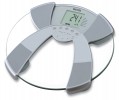The largest weight that is allowed to be placed on the platform of this scale model. If this parameter is exceeded, the scales, at best, will not be able to show the correct data, at worst, they will completely fail. Obviously, the maximum weight is directly related to the purpose, but even kitchen scales can weigh both
up to 5 kg and up to 20 kg.
Actually, floor scales have the largest maximum measurement weight, in such models it can reach
200 kg or even more. And the most delicate are
jewelry models (refer to "Type"). Also note that in mechanical devices (refer to "Mechanism") the scale is usually graduated to the maximum weight.
Now on the market there are scales with such a maximum weight:
up to 1 kg,
up to 5 kg,
up to 10 kg,
up to 50 kg,
up to 150 kg,
up to 200 kg.
The capability for scales to automatically "recognize" the user is present in advanced floor models with diagnostic functionalities.
User identification involves analyzing a range of parameters, beginning with actual weight and extending to the composition of different types of bodily tissues. This feature necessitates an initial measurement session, during which the scales "learn" and subsequently automatically identify the user for future use. Modern models are designed with the understanding that certain diagnostic parameters of an individual may change over time. Consequently, these scales can accurately identify a previously memorized user even if specific body characteristics like liquid percentage or fat content have notably altered. However, this identification isn't completely infallible; even sophisticated scales can occasionally confuse individuals with similar body indicators. Nevertheless, such occurrences are rare, and in most cases, this function is highly reliable.

